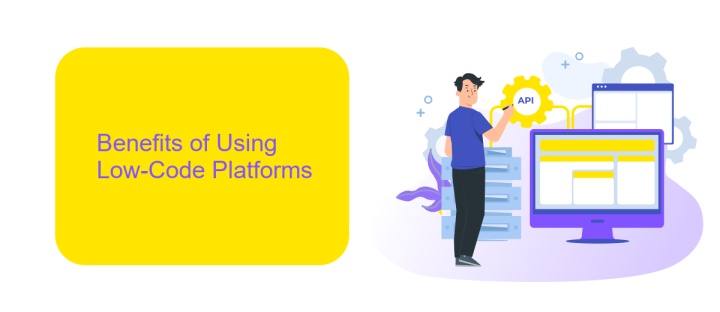Low-Code Application Builder
Low-code application builders are revolutionizing the way businesses approach software development by enabling users to create applications with minimal coding knowledge. These platforms provide intuitive drag-and-drop interfaces and pre-built templates, significantly reducing development time and costs. As a result, organizations can quickly adapt to market changes and innovate more efficiently, empowering both technical and non-technical teams to contribute to the digital transformation journey.
Introduction to Low-Code Application Builders
Low-code application builders have revolutionized the way software is developed, offering a streamlined approach that empowers users to create applications with minimal coding. These platforms provide visual interfaces and pre-built components, enabling rapid development and deployment of applications. By reducing the need for extensive coding expertise, low-code platforms democratize app development, allowing more individuals and teams to participate in the process.
- Accelerated development timelines due to visual modeling tools.
- Reduced dependency on specialized coding skills.
- Enhanced collaboration between IT and business teams.
- Increased agility in responding to changing business needs.
- Cost-effective development with reduced resource requirements.
As businesses strive to keep up with the fast-paced digital landscape, low-code application builders offer a viable solution to quickly adapt and innovate. By simplifying the development process, these platforms enable organizations to focus on delivering value and improving user experiences. As a result, low-code solutions are becoming an integral part of digital transformation strategies across various industries, fostering a culture of innovation and efficiency.
Benefits of Using Low-Code Platforms

Low-code platforms offer significant advantages for businesses looking to accelerate their application development processes. By enabling users to create applications with minimal hand-coding, these platforms drastically reduce development time and costs. This allows companies to respond swiftly to market changes and customer needs, enhancing their competitive edge. Additionally, low-code platforms democratize app creation, empowering non-technical staff to contribute to the development process, fostering innovation and collaboration across departments.
Another key benefit is the ease of integration with existing systems. Platforms like ApiX-Drive simplify the process of connecting various applications and services, ensuring seamless data flow and operational efficiency. This integration capability is crucial for businesses aiming to create a cohesive digital ecosystem without extensive technical resources. Moreover, low-code platforms often come with built-in security features and compliance support, reducing the risk of vulnerabilities and ensuring that applications meet industry standards. Overall, low-code platforms provide a flexible, cost-effective solution for modern businesses seeking to streamline their development processes and enhance their technological capabilities.
Key Features of a Robust Low-Code Platform

A robust low-code platform empowers organizations to rapidly develop applications with minimal hand-coding, offering significant time and cost savings. It is designed to enhance productivity and foster innovation by providing intuitive tools and pre-built components that simplify the development process.
- Drag-and-Drop Interface: A user-friendly drag-and-drop interface allows developers to visually design applications, streamlining the development process.
- Pre-Built Templates: Access to a library of pre-built templates accelerates application development by providing ready-to-use solutions for common business needs.
- Integration Capabilities: Seamless integration with existing systems and third-party services ensures that applications can easily connect and interact with other tools.
- Scalability: The platform should support scalable architecture, allowing applications to grow alongside business needs without performance issues.
- Security Features: Robust security measures are essential to protect sensitive data and ensure compliance with industry standards.
These key features are critical for any low-code platform aiming to deliver efficient and secure application development. By focusing on these elements, organizations can leverage low-code solutions to drive digital transformation and maintain a competitive edge in the market.
Use Cases and Examples of Low-Code Applications

Low-code application platforms are transforming how businesses develop software, enabling rapid prototyping and deployment with minimal coding expertise. These platforms are particularly beneficial for organizations aiming to accelerate their digital transformation efforts. By leveraging visual development tools, companies can reduce development time and costs significantly.
One of the primary use cases for low-code platforms is in automating business processes. Enterprises use these tools to streamline workflows, integrate data from various sources, and improve overall operational efficiency. Additionally, low-code platforms empower non-technical users, often referred to as "citizen developers," to create applications that meet their specific needs without waiting for IT departments.
- Customer Relationship Management (CRM) systems
- Human Resources (HR) management solutions
- Inventory and supply chain management tools
- Custom reporting and analytics dashboards
- Event management and registration systems
In conclusion, low-code application builders are versatile tools that cater to a wide range of industries and business functions. They offer a pragmatic approach to software development, enabling organizations to innovate and adapt quickly in a fast-paced digital landscape. As the demand for rapid application development grows, the adoption of low-code platforms is expected to rise significantly.
Choosing the Right Low-Code Platform for Your Needs
When selecting a low-code platform, it's crucial to assess your specific needs and objectives. Start by identifying the complexity of the applications you plan to build and the level of customization required. Consider the user experience and interface design capabilities of the platform, ensuring they align with your brand's vision. Evaluate the platform's scalability to accommodate future growth and its ability to integrate with existing systems seamlessly. Additionally, assess the platform's support for mobile development if mobile accessibility is a priority for your applications.
Integration capabilities are another key factor. Platforms like ApiX-Drive can streamline the process of connecting various applications and services, enhancing your workflow efficiency. Ensure the low-code platform you choose supports easy integration with such services to avoid potential bottlenecks. Finally, consider the platform's learning curve and the resources available for training and support. A platform that offers comprehensive documentation, tutorials, and a responsive support team can significantly reduce the time it takes for your team to become proficient, maximizing the return on your investment.
FAQ
What is a Low-Code Application Builder?
How does a Low-Code Application Builder benefit businesses?
Can Low-Code platforms integrate with existing systems?
Are Low-Code Application Builders secure?
What are the limitations of using Low-Code Application Builders?
Apix-Drive is a universal tool that will quickly streamline any workflow, freeing you from routine and possible financial losses. Try ApiX-Drive in action and see how useful it is for you personally. In the meantime, when you are setting up connections between systems, think about where you are investing your free time, because now you will have much more of it.

